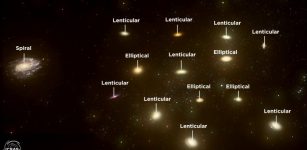Where Is Earth-Like Planet Capable Of Supporting Life As We know It?
Eddie Gonzales Jr. – MessageToEagle.com – Many of us do not believe that Earth is the only habitable planet in the universe. How many and where are the planets with life conditions capable of supporting life as we know it?
If there are, what might they look like?
 Three suns in the sky of the nearest exoplanet Proxima Centauri b (artist’s impression). Image: ESO/M. Kornmesser
Three suns in the sky of the nearest exoplanet Proxima Centauri b (artist’s impression). Image: ESO/M. Kornmesser
More than 4,000 exoplanets are known to date, most of them orbiting single stars like our Sun.
Now astrophysicist Dr. Markus Mugrauer of Friedrich Schiller University Jena has discovered and characterized many new multiple star systems that contain exoplanets.
“Multiple star systems are very common in our Milky Way. If such systems include planets, they are of particular interest to Astrophysics, because the planetary systems in them can differ from our solar system in fundamental ways, ” Mugrauer said in a press release.
Dr. Mugrauer has found several new multiple star systems that contain exoplanets. He focused on more than 1,300 exoplanet host stars with exoplanets orbiting them to see whether they have companion stars He also demonstrated the existence of around 200 companion stars to planetary host stars that are up to 1,600 light-years away from the Sun.
He found that there are both tight systems with distances of only 20 astronomical units (au) – which in our solar system corresponds approximately to the distance between the Sun and Uranus – as well as systems with stars that are over 9,000 au from each other.
The companion stars also vary as to their mass, temperature, and stage of evolution. The heaviest among them weigh 1.4 times more than our Sun, the lightest one has only 8 percent of the Sun’s mass. Most of the companion stars are low-mass, cool dwarf stars that glow faintly red.
However, eight white dwarfs were also identified among the faint stellar companions. A white dwarf is the burnt-out core of a sun-like star, which is only about as big as our Earth, but half as heavy as our Sun.
These observations show that exoplanets can indeed survive the final evolutionary stage of a nearby sun-like star. (The majority of the star systems with exoplanets identified have two stars.)
However, some two dozen hierarchical triple star systems and even a quadruple star system were detected. In the range of distances investigated, of between approximately 20 and 10,000 astronomical units, a total of 15 percent of the stars studied have at least one companion star. This is only about half the frequency expected in general for solar-like stars.
“These two factors taken together could indicate that the influence of several stars in a star system disrupts the process of planet formation as well as the further development of their orbits,” says Mugrauer.
Read more – here.
Written by Eddie Gonzales Jr. – MessageToEagle.com Staff





![Artist’s conception of a rocky Earth-mass exoplanet like Wolf 1069 b orbiting a red dwarf star. If the planet… [more] © NASA/Ames Research Center/Daniel Rutter](https://www.messagetoeagle.com/wp-content/uploads/2023/02/exoplanetlifefeb6-307x150.jpg)




